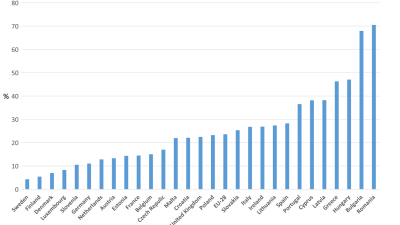A further 800,000 homes will be put out of the reach of people on housing benefit because of government welfare cuts, according to a study by the Chartered Institute for Housing (CIH), commissioned by The Guardian. The CIH found there will be thousands more claimants than properties that are affordable on benefits alone, raising the possibility that the poor will migrate to ‘benefit ghettoes’.
From January 2012, the government has capped housing benefit payments to, for example, a maximum of £250 a week on a two-bedroom home. Allowances have also been scaled back by pegging them to the bottom third of rents in any borough. The result is that in many towns there will not be enough affordable homes to rent for those claiming local housing allowance, the benefit paid to tenants of private landlords. The problem is most acute in central London, where in the boroughs of Westminster and Kensington and Chelsea, more than 35,000 homes will be put out of the reach of people on housing benefit.
It is unlikely that the poor will be able migrate to cheaper parts of the capital: in Newham, east London, there will be twice as many claimants as there are low-cost homes. In Croydon, 17,000 people will be chasing 10,000 properties.
The effect will be felt not just in south-east England. In Birmingham 34,500 housing benefit claimants will be chasing 23,000 low-cost houses. In Liverpool 21,000 people collecting local housing allowance will only be able to afford 12,000 houses.
The changes will also see people forced to move to places where there are far fewer jobs, the Institute warns. ‘The analysis shows that big cities where we expect to find most of the jobs and the most varied employment are the worst hit by the government changes. If this (is supposed) to help people in terms of getting them into work then it looks as if it will not succeed.’
The full article ‘Housing benefit cuts will put 800,000 homes out of reach’ and a related case study ‘It’s not as if we’re living in luxury’ are available on The Guardian website.
Further details are available from the Chartered Institute of Housing.



 PSE:UK is a major collaboration between the University of Bristol, Heriot-Watt University, The Open University, Queen's University Belfast, University of Glasgow and the University of York working with the National Centre for Social Research and the Northern Ireland Statistics and Research Agency. ESRC Grant RES-060-25-0052.
PSE:UK is a major collaboration between the University of Bristol, Heriot-Watt University, The Open University, Queen's University Belfast, University of Glasgow and the University of York working with the National Centre for Social Research and the Northern Ireland Statistics and Research Agency. ESRC Grant RES-060-25-0052.






